
As we enter the new year, the UK economy is still in the grip of uncertainty. High inflation, geopolitical conflicts and the cost of living crisis have presented corporate challenges that could seem never-ending.
For example, geopolitical conflicts are forcing some businesses to consider their supply chains and conduct in-depth due diligence as to where products are sourced – particularly among lower-tier suppliers – to mitigate the risk of disruption.
Equally, while inflation continues to ease, the cost of living remains high. Boards must weigh up any price increases based on what consumers are willing to pay.
With so much to contend with, product and pricing decisions are key to survival. But how can a complex business make these decisions amid so much uncertainty?
The answer lies in data understanding. Reliable data will improve cost visibility across the end-to-end process, from sourcing ingredients through to manufacturing and sales.
Tracking costs and demand
While complex businesses may find that accurate cost data is siloed and difficult to access, creating a holistic cost picture is vital to shoring up the bottom line. For example, greater visibility of cost and profitability will not only help to track gross and net margins, which may vary as costs alter, but also influence demand forecasting. Accurate demand forecasts are crucial to ensuring inventory is optimised and avoiding ‘out-of-stocks’, which could negatively affect customers.
Good data also enables businesses to manage risk, create more efficient buying patterns and optimise production routes and lead times. Additionally, it can bring greater understanding of machine downtime or overall equipment efficiency and demonstrate where improvements can be made to save on time and cost.
Using data to improve cost visibility will also have a positive impact on sales teams as they are able to see the true cost of a product and use this to inform their negotiation strategies and decisions about which products to push and when.
Scenario planning and internal processes
With so much to gain, businesses should look to improve cost visibility across their organisations and their supply chains. Building out data using scenario planning will greatly increase understanding of target areas, such as the supply chain, within the business and allow for complex decisions to be made more quickly.
For example, a business could model a scenario that looks at the impact of a geopolitical conflict or another pandemic on its supply chain and profitability. It could then create alternative sourcing routes to mitigate the risk of disruption, shoring up the business so it is prepared should the event comes to pass.
Scenario modelling isn’t the only thing a business can do to improve cost visibility. It could also establish new internal processes that mandate methods of data capture across teams to report consistently or set future benchmarks. Ensuring that this process is as simple as possible will encourage employee buy-in, and having a single method of data capture will quickly improve your bank of data as well as overall cost visibility.
While some data capture projects may require significant time investment, there are steps businesses can take to improve their data bank in the short term. For example, businesses often find they already have a lot of data, but it is categorised in a way that makes it inaccessible. Improving data accessibility can help to inform business critical KPIs and operational processes, make efficiencies and provide a holistic overview that will assist with complex decision making.
For example, analysing the data in detail and seeking professional advice where appropriate can help businesses to understand where true costs lie and seek to optimise discounts and promotions. This will ensure sales teams know exactly what they are giving away and what effect it will have on the company’s overall profitability.
Pricing decisions
Gaining greater visibility of costs and profitability will help a business make pricing decisions based on data. For example, looking at pricing per customer and seeking to understand the price against the volume of goods sold means benchmarks can be set. It will also help teams to understand profitability on a customer-by-customer basis, which could be particularly useful when looking to plan promotions or sales for the year.
Businesses should also capture data about any products or ingredients with long lead times, factoring in exchange rates if items are shipped from abroad. Capturing this detailed information will not only give decision-makers a better understanding of the process as it is now, but direct their pricing decisions and facilitate better dealmaking with customers.
In times of uncertainty, when the price of key ingredients and products can change on an almost daily basis, businesses need accurate, real-time data to improve cost visibility and make better decisions more quickly.



















No comments yet